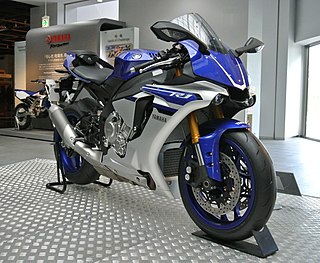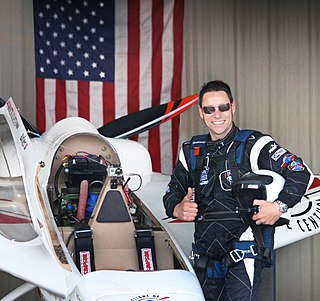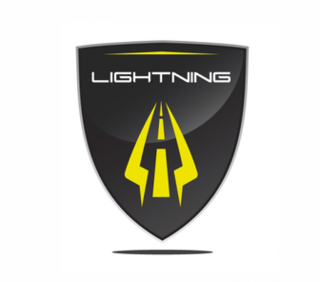
Grand Prix motorcycle racing is the highest class of motorcycle road racing events held on road circuits sanctioned by the Fédération Internationale de Motocyclisme (FIM). Independent motorcycle racing events have been held since the start of the twentieth century and large national events were often given the title Grand Prix. The foundation of the Fédération Internationale de Motocyclisme as the international governing body for motorcycle sport in 1949 provided the opportunity to coordinate rules and regulations in order that selected events could count towards official World Championships. It is the oldest established motorsport world championship.

The Yamaha YZF-R1, or simply R1, is a 998 cc (60.9 cu in) sports motorcycle made by Yamaha. It was first released in 1998, undergoing significant updates in 2000, 2002, 2004, 2006, 2007, 2009, 2015, 2018 and 2020.

MotoCzysz was an American motorcycle company based in Portland, Oregon that intended to compete in MotoGP. The C1 prototype engine was designed with perfect balance not needing a balance shaft. Some of the patented innovations included a slipper clutch with twin clutches, and a unique front suspension. The business also developed a successful electric racing motorcycle, the E1pc.

Voxan Motors is a motorcycle manufacturer founded in Issoire, France in 1995. The brand was particularly known for its 996 cc, 72° V-twin engine. Founded by Jacques Gardette, the project was to build the first French motorcycle company in the global market involving different partners. Alain Chevallier designed the chassis, while Sodemo Moteurs focused on the engine. The first prototype was shown in 1997, and the first production model released in 1999.

Vectrix was an electric vehicle company based in Middletown, Rhode Island, United States, with research and development facilities in New Bedford, Massachusetts and an assembly plant in Wrocław, Poland.

Electric motorcycles and scooters are plug-in electric vehicles with two or three wheels. Power is supplied by a rechargeable battery that drives one or more electric motors. Electric scooters are distinguished from motorcycles by having a step-through frame, instead of being straddled. Electric bicycles are similar vehicles, distinguished by retaining the ability to be propelled by the rider pedaling in addition to battery propulsion.

Zero Motorcycles Inc. is an American manufacturer of electric motorcycles. Formerly called Electricross, it was founded in 2006 by Neal Saiki, a former NASA engineer, in Santa Cruz, California. The company is now located nearby in Scotts Valley.
Mission Motors was an American company founded in 2007 in San Francisco, California. The company was founded with the aim of creating high-performance, electric motorcycles, but later became a supplier of electric vehicle components.

Chip Yates is an American inventor and electrical vehicle pioneer best known for risky record-setting feats in electric vehicles of his own design. He designed and built the record-breaking SWIGZ electric motorcycle, which in 2011 he rode over 200 mph (322 km/h) to 8 official world land speed records, 4 AMA National Championship Records, the Pikes Peak International Hill Climb record, and the Guinness Book of World Records title of “World’s Fastest Electric Motorcycle”. Dubbed "the world’s most powerful electric superbike", the motorcycle is now on display at the Petersen Automotive Museum's exhibit 'Electric Revolution', curated by Paul d'Orleans.

The Harley-Davidson LiveWire is an electric motorcycle by Harley-Davidson, their first electric vehicle. Harley-Davidson says the maximum speed is 110 mph (180 km/h) with claimed 105 hp (78 kW) motor. The LiveWire, released in 2019, targets a different type of customer than their classic V-twin powered motorcycles.

Lightning Motorcycle Corp. is an American manufacturer of electric motorcycles. CEO and Founder Richard Hatfield started the company in 2006 in San Carlos, California.

Energica Motor Company was an Italian manufacturer of electric motorcycles. The Energica project was started in 2010 in Modena, Italy, by CRP Group, an international company involved in computer numerical control machining and additive manufacturing with advanced selective laser sintering materials. Energica Motor Company was officially founded in 2014 with the aim of creating high-performance sustainable motorcycles.
The CRP Group is an Italian industrial group specialising in additive manufacturing, Rapid Prototyping and high precision machining services in the motorsport, automotive, space, boating, design, medical and UAV sectors. In the automotive sector, CRP Group has been building electric motorcycles since 2014 through the start-up Energica Motor Company, a member of its group.

Electric motorsport is a category of motor sport that consists of the racing of electric powered vehicles for competition, either in all-electric series, or in open-series against vehicles with different powertrains. Very early in the history of automobiles, electric cars held several performance records over internal combustion engine cars, such as land speed records, but fell behind in performance during the first decade of the 20th century.

The Honda CBR250RR is a CBR series 250 cc (15 cu in) twin-cylinder sport bike made by Astra Honda Motor, a subsidiary of Honda in Indonesia. It was unveiled in July 2016 in Jakarta. Production was started in November of the same year for the 2017 model year. It is the first CBR motorcycle to have a twin-cylinder engine on RR moniker. It is also the smallest Honda motorcycle to wear a CBR-RR badge. Previously, Honda also used the CBR250RR name for their four-cylinder sport bike sold between 1990 and 1996. The bike is officially sold in Indonesia, Japan, Hong Kong, Macau, Thailand, and Malaysia.
Moto E or variation may refer to:

The Ducati Panigale V4 is a sport bike with a 1,103 cc (67.3 cu in) desmodromic 90° V4 engine introduced by Ducati in 2018 as the successor to the V-twin engined 1299. A smaller engine displacement version complies with the Superbike category competition regulations which state "Over 750 cc up to 1000 cc" for three and four cylinder 4-stroke engines.
The FIM Enel MotoE World Championship is a class of motorcycle racing that uses only electric motorcycles. The series is sanctioned by the FIM and the inaugural season in 2019 was due to support MotoGP at five of the European circuits.

The 2019 MotoE World Cup was the inaugural season of the MotoE World Cup for electric motorcycle racing, and was a support series of the 71st F.I.M. Grand Prix motorcycle racing season.

The 2019 German motorcycle Grand Prix was the ninth round of the 2019 MotoGP season. It was held at the Sachsenring in Hohenstein-Ernstthal on 7 July 2019.

















